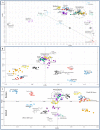Whole genome structural analysis of Caribbean hair sheep reveals quantitative link to West African ancestry
- PMID: 28662044
- PMCID: PMC5490989
- DOI: 10.1371/journal.pone.0179021
Whole genome structural analysis of Caribbean hair sheep reveals quantitative link to West African ancestry
Abstract
Hair sheep of Caribbean origin have become an important part of the U.S. sheep industry. Their lack of wool eliminates a number of health concerns and drastically reduces the cost of production. More importantly, Caribbean hair sheep demonstrate robust production performance even in the presence of drug-resistant gastrointestinal nematodes, a rising concern to the industry. Despite the growing importance of hair sheep in the Americas their genetic origins have remained speculative. Prior to this report no genetic studies were able to identify a unique geographical origin of hair sheep in the New World. Our study clarifies the African and European ancestry of Caribbean hair sheep. Whole-genome structural analysis was conducted on four established breeds of hair sheep from the Caribbean region. Using breeds representing Africa and Europe we establish an objective measure indicating Caribbean hair sheep are derived from Iberian and West African origins. Caribbean hair sheep result from West African introgression into established ecotypes of Iberian descent. Genotypes from 47,750 autosomal single nucleotide polymorphism markers scored in 290 animals were used to characterize the population structure of the St. Croix, Barbados Blackbelly, Morada Nova, and Santa Ines. Principal components, admixture, and phylogenetic analyses results correlate with historical patterns of colonization and trade. These patterns support co-migration of these sheep with humans.
Conflict of interest statement
Figures




References
-
- Benavides MV, Sonstegard TS, Van Tassell C. Genomic Regions Associated with Sheep Resistance to Gastrointestinal Nematodes. Trends Parasitol. 2016. June;32[6]:470–80. doi: 10.1016/j.pt.2016.03.007 - DOI - PubMed
-
- Jones K. Marketing Could Boost the U.S. Sheep Industry [Internet]. [cited 2016 Sep 20]. http://www.ers.usda.gov/amber-waves/2004-february/marketing-could-boost-...
-
- Álvarez I, Capote J, Traoré A, Fonseca N, Pérez K, Cuervo M, et al. Mitochondrial analysis sheds light on the origin of hair sheep. Anim Genet. 2013. June 1;44[3]:344–7. doi: 10.1111/j.1365-2052.2012.02398.x - DOI - PubMed
-
- Salle G, Jacquiet P, Gruner L, Cortet J, Sauve C, Prevot F, et al. A genome scan for QTL affecting resistance to Haemonchus contortus in sheep. J Anim Sci. 2012. December 1;90[13]:4690–705. doi: 10.2527/jas.2012-5121 - DOI - PubMed
-
- Amarante AFT, Bricarello PA, Rocha RA, Gennari SM. Resistance of Santa Ines, Suffolk and Ile de France sheep to naturally acquired gastrointestinal nematode infections. Vet Parasitol. 2004. February 26;120[1–2]:91–106. doi: 10.1016/j.vetpar.2003.12.004 - DOI - PubMed
MeSH terms
LinkOut - more resources
Full Text Sources
Other Literature Sources

